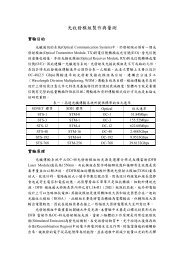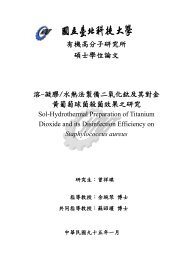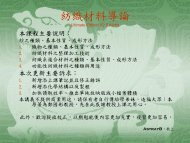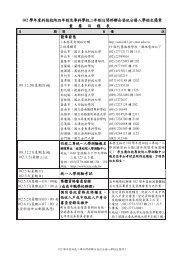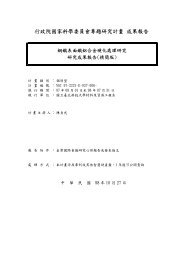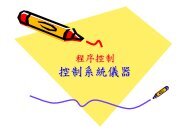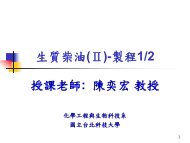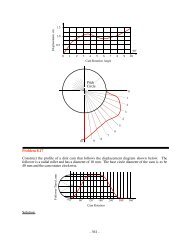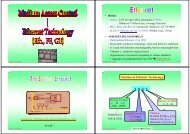Study of self-crimp polyester fibersS. P. Rwei,1. Institute of Organic and Polymeric Materials,National Taipei University of Technology,Taipei, Taiwan 106, R.O.C.ABSTRACTSelf-crimp polyester yarns were manufactured using a conjugated spinning process involvingtwo parallel but attached fibers with different shrinkage properties. A theoretical model proposedby Denton was proved to be very useful for predicting crimp potential. Maintaining identical orvery similar melt viscosities of the two components was demonstrated to be very critical for obtaininga straight interface and eliminating the dog-legging problem. The crimp tests illustrate that thetriangular shapes are found to be superior to the round cross section. The optimum volume ratio formaking a self-crimp bicomponent skein is 50/50.KEYWORDS: self-crimp yarn, bicomponent fiber, thermal shrinkage, crimp potential, elastic recoveryINTRODUCTIONSelf-crimp fibers behave like naturalwool with a textured appearance. The crimpsare born from a composite of two parallel butattached fibers with differing shrinkage orexpansion properties. Since the crimp isnaturally born, the false twist or air texturinginvolved in typical fiber processing forsynthetic fibers becomes unnecessary and canbe eliminated. The elimination of this elementcan significantly cut the manufacturing costs,creating a “dream product” for asynthetic-fiber producer. Another importantcharacteristic of the self-crimp yarn is that thecrimp is not imposed on the fiber from theoutside, but rather results from therearrangement of the internal molecular structureof the fiber material. Usually the crimpgenerated by either false twist or air texturing isimposed on the fiber via mechanical deformationof the fiber as a 2-Dimensional Zig-Zag crimp(1-4). In some applications the crimped fibermust be extremely resilient, for example in fiberfilling for pillows, furniture and so on. In suchcases, a mechanical 2-D crimp is insufficient,and instead, a latent helical “self crimping” ofthe fiber is necessary.Nevertheless, spinning of conjugatedfiber represents the greatest challenge for thefiber industry (5-7). The technical difficultiesinclude: (1) the melt instability between thetwo ingredients (2) the need to instantly adjustthe throughput ratio (3) the complex design ofthe conjugated spinnerette. Du Pont Co.started to study the first self-crimp yarn (PP)during the early 1960s. Recently, the newlycommercialized self-crimp products of DuPont, polyester T-400 and nylon T-800, havebecome very popular in the market. Followingthe success of Du Pont, Unitica Co. alsocommercialized the self-crimp yarns, Z-10 andS-10. Furthermore, a nylon/polyurethanebicomponent filament, Sideria, developed byKanebo Co., can adapt heat treatment toself-crimp itself to an appropriate degree.Self-crimp yarns have apparently becomeconspicuous in the fiber industry (8-12);however, few researchers have investigatedthe crimp mechanisms and the effect offiber-processing parameters on the “crimppotential”. This study therefore attempts toproduce and elucidate a new direction forself-crimp fiber development.This study presents the results of aninvestigation on crimp formation thatconsiders several parameters, including: (1)various cross-sectional geometries such ascircles and triangles. (2) combination ofvarious polyester materials, for example PET(polyethylene terephthalate), CD (Cation2
Dyeable PET), PTT (polytrimethyleneterephthalate), and PBT (polybutyleneterephthalate), in various ratios. (3) thefiber-processing parameters (spinningtemperature, heat treatment and so on). Priorto studying the crimp, this study first examinesthe optimum rheological condition for fiberspinning. The results of this study can providefurther insight into the curling mechanism ofself-crimp yarn. Moreover, a crimp model isassessed; a method for characterizing crimp isestablished, and finally but most importantly,the optimum conditions for producing a highquality self-crimp yarn are identified.THEORETICAL REVIEWThe basic driver of self-crimping is ashrinkage differential within the fiber. Earlytheories to study the crimp mechanism werebased on mechanical models of bimetallic strips.During the early 1980s, Denton developed anadvanced equation (Eqn. 1) that used ageometrical and mechanical approach to describethis effect (13). Equation (1) has been provenpractical when applied to most fibers withregular cross-sections (Figure 1).1 / R = ( A 1 * μ 1 * △ ) / I 0 (1)where1/R denotes the crimp curvature;A 1 represents the area of either component; μ1 the first moment of A 1 , is defined as the linefrom the center of A 1 to the bulk center of thecomposite; △ denotes the fractionaldifferential shrinkage between the components,and I 0 , the second moment of area of the wholefiber cross-section, is given by summing theincrements of area times the squares of theirdistances from the axis of reference.Denton reached three importantconclusions based on Eqn. (1), as summarizedbelow:(a.) Fibers with a single interface exhibitthe best crimp potential. (b.) The crimp potentialis maximized in a skein with a straight interfacepassing through the center of the cross-sectionalarea of a conjugated fiber. (c.) The crimppotential is zero for any cross-section with acenter of symmetry (such as centric core/sheath).Eqn. (1) demonstrates that the amount ofthe differential shrinkage is the determinant ofcrimp curvature for a given cross-section.However, to obtain sufficient crimp thedifferential shrinkage must exceed a certainvalue. The differential shrinkage can be obtainedin different ways and the thermal shrinkagewithout steam was used in this work.EXPERIMENTALSpinning Setup and Fiber DrawingTwo polyester resins, comprising PET as afixed ingredient and another conjugated partselected from PBT, CD, or PTT, were spunsimultaneously using a bicomponent spinning set.PET resin with IV - 0.64 (dissolved in a solventof phenol/tetrachloroethane 6/4 at roomtemperature) and CD with IV – 0.45 weresupplied by Hsing-Kuang Ltd. PBT resin withIV - 0.9 was obtained from Chung ChunPetrochemical Ltd. PTT resin with IV – 0.95 wassupplied from Nan Ya Plastics Co. Notably, allthe resins used were bright grade except for PETresin (delustered grade with TiO 2 0.32 %) toobtain a high contrast image in analyzing thecross section of fiber. Before melt spinning, thetest polymers were dried to maintain a moisturelevel of below 100 ppm.Prior to the melt spin, the melt-viscositywas measured via a continuous rheometry(Haake Polylab System) to determine theoptimal spinning temperature. In thisinvestigation, two individual single-screwextruders extruded PET and its conjugated partseparately into the conjugated spin-pack. Thespin-pack was a side-by-side device designed byHILLS Co. Moreover, a Barmag take-up winder(BARMAG DR4) was employed for collectingthe yarns with a winding speed of 3500 m/min.A 30-minute filament package with a denier of150 den./24 fils. was gathered for eachexperimental condition.Crimp CharaterizationCalculate the crimp potential, crimpshrinkage and crimp index of each skein, usingthe following equation (14):CP = [(L 2 – L 1 ) / L 1 ] * 100 % (2)where CP denotes the crimp potential %; L 1represents the final skein length with 2.5 g load(crimped length following treatment) and L 2 isthe final skein length with 700 g load(uncrimped length after treatment).The elastic recovery test was conductedbased on the German Standard Test ProcedureDIN53835. A tensile-recovery instrument(Textechno Statimat ME, Ger.) was employedwith pretension of 0.5 cN/tex, tensile rate of 200mm/min, and recovery period of 5 minutes. Theelastic recovery (ER) was calculated accordingto Eqn. (3) shown as follows (15):ER = [(2L 0 - L 1 ) / L 0 ] * 100% (3)where L 0 denotes the initial length of skeinunder pretension; L 1 represents the final skeinlength following elongating to certain degreeand then recovering for 5 minutes.RESULTS AND DISCUSSIONMelt Spinning Stability3



